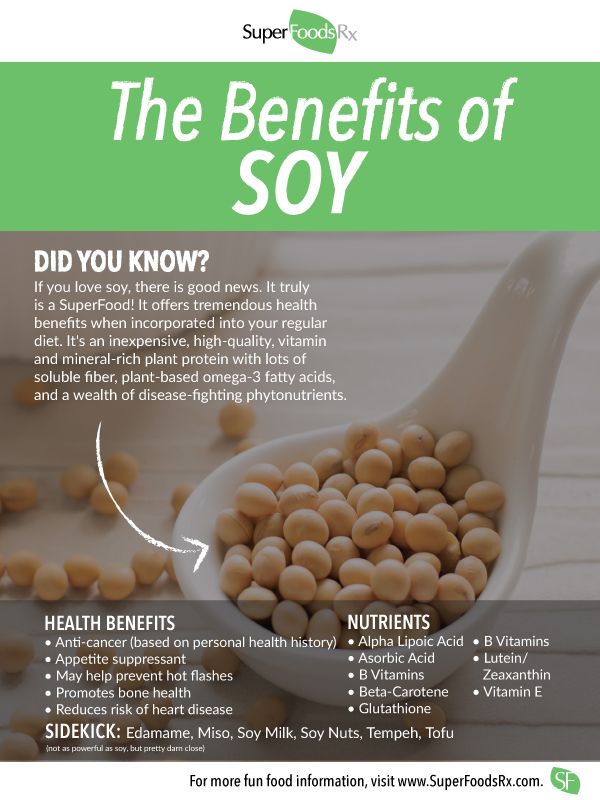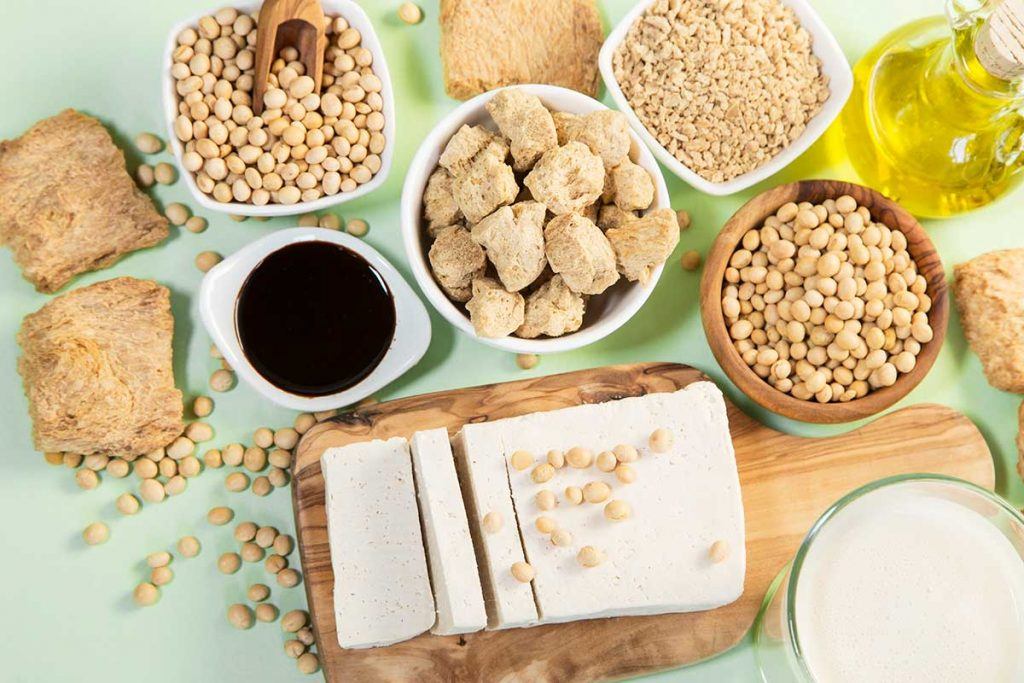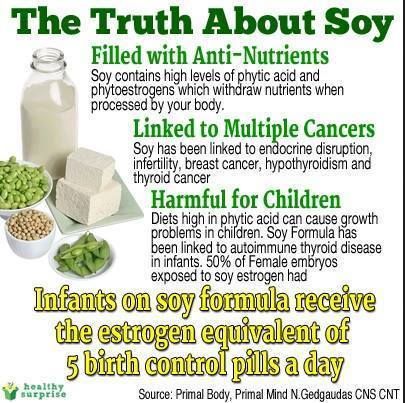Soy is commended as a health food by some, claiming the calming of hot flashes, defending against osteoporosis, and guarding against hormonal cancers such as breast and prostate. On the other hand, others reject soy for fear that it may cause breast cancer, thyroid problems, and dementia. So, in all fairness, this article covers soy: the good and the bad.
What is Soy?
Soy comes from the soybean, which is a species of legume local to East Asia, which has abundant uses. Conventional, unfermented food uses of soybeans involve tofu and tofu skin.
What is Soy used for?
Soybeans are harvested for their oil as well as meal for the animal feed. A smaller percentage is processed for human ingestion and made into products including soy protein, soy flour, soymilk, tofu, and many retail food products. Soybeans are additionally used in many non-food or industrial products.
For human consumption – Practically, all soybeans are harvested for their oil. Soy processors obtain the raw soybeans and remove the oil from the meal. The oil may be processed for cooking and other safe to eat uses or sold for biodiesel production or industrial services. The processors oven-bake the high-protein fiber after the oil is removed and sell it for animal feed.
Soybean oil is used in the cooking and frying of foods. Margarine is also a product made from soybean oil. Mayonnaises and salad dressings are produced with soybean oil.
Various foods are packed in soybean oil (i.e., sardines, tuna, etc.) Crackers, baked bread, cookies, cakes, and pies generally contain soybean oil.
Animal Feed – The high-protein fiber that remains after the oil has been removed is toasted and prepared into animal feed for cattle, pork, poultry, and other farm animals and pets. The swine and poultry industries are foremost buyers of soybean meal. More than half of the soybeans developed for livestock feed are fed to poultry, about one-quarter are fed to swine, and the balance is used for pet food, dairy cattle, and beef cattle.
Soy protein is found in fish food more and more, for both home aquariums and fish raised for eating. At one time, most marine species were fed fishmeal, but the scarcity and increasing cost of fishmeal has led producers to switch to high protein soymeal for various marine species. Presently, soy protein may be found in feed for most animals around the world.
Additional Uses – Soy additionally has a plethora of industrial uses.
Biodiesel — biodiesel fuel for diesel engines can be formed from soybean oil by a straightforward process known as transesterification. This procedure eliminates the glycerine from the oil, resulting in soy biodiesel. Soy biodiesel is cleaner burning than diesel oil that is petroleum-based. Using it reduces particulate emissions, is non-toxic, renewable, and environmentally friendly.
Biocomposites—Biocomposites are building materials produced from recycled newspapers and soybeans. They substitute other products conventionally prepared from wood, such as flooring, furniture, and countertops.
Laminated plywood, particleboard, and finger-jointed lumber are produced with soy-based wood adhesives.
Soy products are additionally established in many well-known home and commercial carpet brands and auto upholstery applications.
Soy oil yields an environmentally welcoming solvent that safely and rapidly removes oil from creeks, streams, and shorelines without causing harm to humans, animals, and the environment. Soy is also an ingredient in numerous cleaners, solvents, industrial lubricants, and paints.
Candles that are made with soybean oil will burn longer but with less smoke and soot.
Soy ink is more excellent than petroleum-based inks for the reason that soy ink is renewable, non-toxic, and environmentally friendly, and it is easy to clean up.
Soy crayons made with soy oil replace regular crayons that use petroleum oil making them non-toxic and safer for children.
Soy-based lubricants are as good as petroleum-based lubricants, but they can also withstand higher temperatures. Additionally important, they are renewable, non-toxic, and environmentally friendly.
Soy-based hydraulic fluids and rail flange lubricants are together with the more up-to-date products produced with check-off funds.
Soy-based foams are presently being produced to use in automotive interiors, coolers, refrigerators, as well as footwear. Vehicles rolled off the production line with soy foam in the seats beginning in 2007. The latest automotive and equipment industry uses followed, including lubricants, body parts, interiors, and seating.
What are the Health Benefits of Soy?
Soybeans are innately plentiful in protein and have all of the essential amino acids the body requires. They are also rich in plant fats, fiber, and several essential minerals, vitamins, and valuable plant compounds.
In addition to their vitamin and mineral components, soybeans are a natural source of polyphenols, a class of antioxidants that may protect the body against cell damage and conditions like heart disease.
Soybeans are particularly rich in isoflavones, a subclass of polyphenols known as phytoestrogens, because of their ability to attach to and activate estrogen receptors in the body.
Soy isoflavones are thought to be one of the principal reasons behind the many professed health benefits of soy-based foods. Boiled soybeans have 90–134 mg of isoflavones per 3.5 ounces (100 grams), depending on the grade of the bean.
Due to their resemblance in structure, soy isoflavones are often considered to imitate the hormone estrogen. However, research suggests that soy isoflavones differ from estrogen in numerous ways, each having distinctive effects on the body.
As a result of the above, soy-rich diets have been connected to a few potential health benefits.
May aid in lowering cholesterol – Several studies propose that diets abundant in soy foods can aid with the lowering of LDL (bad) cholesterol and the raising of HDL (good) cholesterol.
For example, one recent analysis proposes that a median intake of 25 grams of soy protein daily may help reduce total and LDL (bad) cholesterol levels by around 3%.
However, the report’s authors believe that, in practice, reductions may be more significant when individuals consume soy protein in place of animal protein. However, additional research is necessary to confirm this.
Another review proposes that soy-rich diets may help reduce complete and LDL (bad) cholesterol levels by 2–3%. They may additionally raise HDL (good) cholesterol by 3% and lower triglyceride levels by approximately 4%.
At this time, individuals with current risk factors for heart disease, such as high cholesterol, obesity, or type 2 diabetes, appear to be among those who benefit most from soy-rich diets.
Additionally, soy foods that are minimally processed, such as soybeans, tofu, tempeh, and edamame, appear to improve cholesterol levels more than processed soy products and supplements.
Can protect heart health – According to a study, diets that are rich in legumes that include soy may aid in lowering the risk of heart disease.
It additionally emerges that soy isoflavones may aid in the reduction of inflammation in blood vessels and improve their elasticity — two factors believed to protect the health of your heart (17Trusted Source).
A new study further links soy-rich diets to a 20% and 16% lower risk of stroke and heart disease, respectively.
Additional research proposes that diets plentiful in soy foods may reduce the risk of dying from heart disease by up to 15%.
Can lower blood pressure – Soybeans and foods produced from them are generally rich in arginine, an amino acid believed to aid with regulating blood pressure levels, according to a study.
Soybeans are additionally plentiful in isoflavones, which is another compound believed to offer blood-pressure-lowering benefits.
In one study involving postmenopausal women, eating 1/2 cup (43 grams) of soy nuts daily was found to reduce diastolic blood pressure (the bottom number of a blood pressure reading) by around 8% in some, but that does not include all women.
Other studies connect daily intakes of 65–153 mg of soy isoflavones to blood pressure reductions of 3–6 mm Hg in individuals with high blood pressure.
On the other hand, it is unclear whether these small blood-pressure-lowering benefits apply to individuals with normal and elevated blood pressure levels.
Some studies suggest both may benefit, while others offer that only individuals with high blood pressure would experience this effect.
Undoubtedly, more research is required on this topic, but in the meantime, the blood-pressure-lowering effects of soy, if any, seem to be minute.
Can lower blood sugar – A review
including 17 randomized control studies, which is the gold standard in research, proposes that soy isoflavones may slightly aid to reduce blood sugar and insulin levels in menopausal women.
Soy isoflavones can additionally help lower insulin resistance, which is a condition in which cells no longer act in response to insulin normally. Eventually, insulin resistance can result in high blood sugar levels and lead to type 2 diabetes.
Additionally, there is some verification that soy protein supplements may help slightly lower blood sugar and insulin levels in individuals with type 2 diabetes or metabolic syndrome.
Metabolic syndrome refers to a group of conditions, including high blood sugar, cholesterol levels, blood pressure, and abdominal fat, that collectively tend to increase a person’s risk of type 2 diabetes, heart disease, and stroke.
However, these results aren’t unanimous, and several studies have failed to find a strong link between soy foods and blood sugar control in healthy people and those with type 2 diabetes (25Trusted Source, 26Trusted Source, 27Trusted Source).
Therefore, more studies are required before solid conclusions can be made.
Can improve bone health – The low estrogen quantities experienced during menopause can cause calcium to leach from the bones.
This resulting bone loss can cause postmenopausal females to develop weak and brittle bones as a consequence, a condition known as osteoporosis.
There is some evidence that suggests intakes of 40–110 mg of soy isoflavones per day can reduce bone loss and progress markers of bone health in menopausal women. However, additional research is required to confirm these findings.
Can reduce the risk of certain types of cancer – Soy-rich diets can also help lower the risk of certain types of cancer.
For example, studies propose that high ingestion of soy isoflavones can reduce the risk of endometrial cancer (cancer of the uterus) by around 19%.
Additionally, some studies have connected soy-rich diets to a 7% lower risk of digestive tract cancers and an 8–12% lower risk of colon and colorectal cancers, particularly in women.
Conversely, according to a recent study, men eating soy-rich diets can benefit from a lower risk of prostate cancer.
Lastly, one recent review of 23 studies connected diets plentiful in soy foods to a 12% lower risk of dying from cancer, mainly cancers of the stomach, large intestine, and lungs.
What Foods Have Soy?

Various foods include soy, for example, soy sauce, soy meat alternatives, tofu, soy flour, and soybean oil, which may be found in supermarkets and natural, health, and Asian food stores.
The following foods contain soy:
Whole Soybeans – When soybeans advance in the pod, they ripen into a hard, dry bean, similar to other legumes. For the most part, mature soybeans are yellow, but a few are brown and black.
Whole soybeans are a first-rate supply of protein and dietary fiber. They may be heated and used in sauces, stews, and soups. Whole soybeans that have been soaked can be roasted for snacks and available in natural food stores and select supermarkets. When grown minus the chemicals, they are referred to as organically grown soybeans.
Tofu – Tofu, also called soybean curd, is a soft, smooth soy product made by curdling fresh, hot soymilk with a coagulant. Tofu contains a mild flavor and quickly absorbs the flavors of marinades, spices, and other ingredients. Tofu is full of high-quality protein and B vitamins and is low in sodium. There are two(2) significant varieties of tofu:
- Water-packed tofu comes in extra-firm, firm, and soft varieties. This tofu is thick and solid and stands up well in stir fry dishes and soups, on the grill, or anywhere that it is desired for tofu to maintain its shape.
- Silken tofu comes in extra-firm, firm, soft, and reduced-fat varieties. This tofu is made by a slightly different procedure that results in a smoother product. Silken tofu works agreeably in pureed or blended dishes.
Meat Alternatives – Meat substitutes containing soy protein or tofu are used to emulate meat, for example, sausages, burgers, hot dogs, and bacon. Usually, they are cholesterol-free and have less fat than meat. They are first-rate suppliers of protein, iron, and B vitamins.
Edamame – These soybeans are collected while the beans are still green and sweet tasting. They can be handed out as a snack or a major vegetable after boiling in lightly salted water for 15 to 20 minutes. They are potent with protein and fiber and contain no cholesterol. Edamame can be purchased shelled or in the pod in the supermarket’s produce section or frozen food aisle.
Miso – Miso is a robust and salty soy paste used in Japanese cooking. The Japanese produce miso soup and use miso to flavor various foods, for example, sauces, dressings, and marinades. Miso paste requires refrigeration. Miso contains minimal soy protein and is high in sodium.
Soymilk – Soybeans that have been soaked, ground fine, and strained yield fluid called soybean milk. Plain, unfortified soymilk is a first-rate supply of high-quality protein and B vitamins, but it lacks calcium, and vitamin D. However, fortified versions are available.
Soymilk can be sighted in non-refrigerated containers or the dairy case at the supermarket. It is additionally sold as a powder to be mixed with water.
Soymilk is a great milk substitute for individuals who are lactose intolerant. It may be used as a beverage or as a substitute in place of milk for cooking.
Soy Nuts – Roasted soy nuts are whole soybeans that have been saturated in water and then baked until browned. Soy nuts are available in an assortment of flavors. They are rich in protein and isoflavones and comparable in texture and flavor to peanuts.
Soy Sauce (Tamari, Shoyu and Teriyaki) – Soy sauce is a dark brown liquid made from soybeans through fermenting. Soy sauce contains small amounts of soy protein and is high in salt.
Two (2) types of soy sauce are shoyu and tamari. Shoyu is a combination of soybeans and wheat. Tamari is produced only from soybeans and is a by-product of miso. An additional sauce containing soy sauce is teriyaki sauce. It has soy sauce and other ingredients, for instance, sugar, vinegar, and spices.
Tempeh – Tempeh is a soybean product that is tender and chunky. Whole soybeans, occasionally mixed with another grain like millet or rice, are fermented and pressed into a bar or cake with a nutty or smoky. It may be marinated, sliced, grilled, and added to casseroles, soups, or chili. It is usually found in Asian and health food stores.
Textured Soy Protein – Textured soy protein (TSP) pertains to products made from textured soy flour, textured soy protein concentrates, as well as spun soy fiber. Textured soy flour contains approximately 70 percent protein and maintains most of the bean’s dietary fiber. Textured soy flour can be purchased dried in granular and chunk style. When mixed with water, it has a chewy texture. It is commonly used as a meat extender. One (1) of the more well-known brands is called Textured Vegetable Protein (TVP).
There are many kinds of food alternatives made with soy, such as “chicken-less” nuggets, hamburgers, hot dogs, soy bacon, cheese, corn dogs, and ice cream.
What are the Health Concerns about Soy?

Some individuals are concerned about including soy in their diets because of the following areas of concern:
- Antinutrients. Soybeans have compounds that can lessen the body’s ability to take in the vitamins and minerals they contain. Soaking, sprouting, fermenting, and cooking are ways to alleviate these antinutrient levels in soy (study, study, study, study).
- Cancer risk. Some people suppose that soy isoflavones can raise the probability of breast or endometrial cancer. However, a majority of studies find no adverse effect. In some cases, they may even offer some protection against certain cancers.
- Danger to babies. Many people fear that soy formula can negatively affect the brain, thyroid, sexual, or immune development. Despite that, studies typically fail to observe any long-term adverse effects of soy formula in healthy, full-term babies.
- Digestive issues. Animal studies indicate that the antinutrients in soy can reduce the gut’s barrier function, possibly resultant in inflammation and digestive problems. On the other hand, more human studies are required to confirm this (study).
- Estrogen-mimicking effects. Soy isoflavones are frequently believed to imitate the female reproductive hormone estrogen. Although they are similar in structure to this hormone, soy isoflavones have weaker and slightly different effects than estrogen (review).
- Feminizing effects in men. Many are concerned that soy isoflavones can reduce the production of the male hormone testosterone. However, human studies find a weak connection between the two (study).
- GMOs. Soybeans are frequently genetically modified (GMO). GMO soy can contain a reduced amount of nutrients and additional herbicide residues than conventional or organic soy. More research about the long-term health effects of GMO soy is required.
- Thyroid function.
Test-tube and animal research proposes that some compounds established in soy may lessen thyroid gland function. However, human studies find little to no adverse effects, particularly in humans with healthy thyroid function (study, study, study).
It is important to note that while these apprehensions are common, hardly any of them are supported by sound science. Furthermore, when adverse effects have been observed, they frequently followed the consumption of vast amounts of soy.
For example, men who expressed experiencing feminizing effects from soy consumed amounts up to 9 times larger than men’s average intake with soy-rich diets. Although possible, it would be difficult for most individuals to consume that amount of soy daily (study).
Soy-rich diets may boost heart health and decrease blood pressure, blood sugar, and cholesterol levels. They can additionally enhance fertility, reduce symptoms of menopause, and protect against certain cancers. However, more research is needed.
The concerns regarding soy are commonly cited. Generally, hardly any are sustained by solid science, and additional research is required to confirm the ones that have not been verified.
The Bottom Line
While there are mixed conclusions regarding soy, it appears that the health benefits outweigh the health concerns. Therefore, it seems that consuming soy in moderation is beneficial.
Of course, organic is the optimal way to go.
Questions, comments, concerns, and experiences with soy are welcomed below. You will receive a response.
For more articles, click www.universal-health-products.com
Good Health!!

Hello there! This is a great article. I grew up with soy products and so it is something that I am used to consuming. Although I consume it often with my family, I honestly had no idea of the health benefits. The form that I tend to eat the most soy in is tofu. I did not know about the anti-cancer properties, appetite suppressant, as well as others. But I guess it almost felt counter-productive when I got to the health concerns section of your article. I guess it really just comes down to eating in moderation if one desires to continue to eat it. Thanks for this information.
I agree Mike – All things in moderation is the safest road to travel.
Thanks for commenting!
I have been told that taking too much soy wasn’t good for me as a man. And I see that you also address this point. But you also state that the link between soy and this outcome is not strong enough. And seeing all the benefits, I would not stop taking soy because of a suspicion that is not well grounded.
I agree with you, Paolo. If it’s working for you, go for it! As I like to say: if it ain’t broke, don’t fix it!
Thanks for commenting!